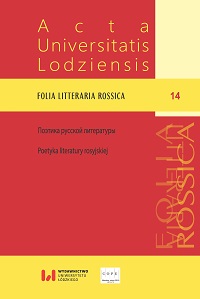On Some Features of Derzhavin’s Late Metric-Stanzaic Repertoire
DOI:
https://doi.org/10.18778/1427-9681.14.04Keywords:
Derzhavin, versification, metric-stanzaic repertoire, composition, “Poligimnii” [To Polyhymnia]Abstract
The paper discusses versification features of the texts that make up the fifth volume of Sochineniya Derzhavina [The Works of Derzhavin], the last book compiled by the poet during his lifetime. These 57 poems have rarely been an object of scholarly attention and have not previously been analysed in terms of versification as a corpus. The author of the article has compiled a metric-stanzaic directory for this volume. An analysis of the material indexed this way shows that most of the poems are written in one kind of stanza. Only “Tseleniye Saula” [The Cure of Saul], a compositional centre of the collection, is written in various types of stanzas. Another work pivotal for the book, “Gimn liro-epichesky” [The Lyric-epic hymn], is written in complex Pindaric triads. Among other stanzas, the poet shows a predilection for the 8- and 6-line strophes; many poems are also written in the odic stanza (and all the odic stanzas are cast in the 4-foot iambics, traditional for them) or use variations thereof. The quatrain, one of the most popular stanzas in Russian poetry, does not occur very often in the book. Moreover, none of the quatrains is written in a 4-foot iamb — unlike the stanzas with 8 lines, more than 70% of which employ this metre. It is interesting that Derzhavin does not give preference to the rhythmic scheme of the 4-foot iamb, which is considered characteristic of his earlier poetry (with the first and fourth feet strong, second and third feet weak). The poet often employs more stresses than required by a given metre, and they can have different functions. For example, in the poem “Problesk” [A Glimpse] it is connected with the plot of the poem: the lines which speak of the difficulty of walking a path contain a high number of such “excess” stresses, through which the reader must “wade”. In some cases, a variable reading is possible (and, accordingly, the decision on the presence or absence of an extra stress) – where neither of two points of view contradicts the text, the reading depends on the arrangement of logical stresses. Transaccentuation, on the other hand, is not very common in Derzavin’s fifth volume. There are several instances of poems written in metres that must have seemed to Derzhavin similar to the ones used in the Antiquity. The most interesting of these is “Poligimnii” [To Polyhymnia], the poem that closes the collection. It is dedicated to the theme of the poet and poetry and as if serves demonstrating Derzhavin’s own skills. He seems to be stylising the meter to resemble “antique” ones (although the result is unlike any of the meters traditionally employed in Russian poetry with a view to imitating antique metrics). The choice of the stanzas is also unusual – they consist of 7 lines, with the first four lines in each rhymed (and the type of line endings varies throughout the poem), while the latter three are left unrhymed. The distribution of stresses in the line endings of the blank verses used in the last stanza occurs only once in the poem. This stanza, which is the semantic core of the poem and which closes the collection with the final line “I will be immortal, I will!”, was apparently written with intentional sophistication. In general, the analysis of the metric-stanzaic repertoire of the late Derzhavin makes it possible to see the poet as a real old master who pays attention to versification issues, avoids monotony, looks for new metrical patterns, and composes his collection skilfully – also from the point of view of versification features of the texts.
Downloads
References
Altshuller, Mark G. Oratoriya ‘Tselenie Saula’ v sisteme pozdnei liriki Derzhavina. In: XVIII vek. Vol. 21: Pamiati Pavla Naumovicha Berkova (1896–1969), ed. N. D. Kochetkova. Sankt-Peterburg: Nauka, 1999: 269, 281.
Google Scholar
Brown, John. The Cure of Saul, a sacred ode. London: L. Davis and C. Reymers, 1763.
Google Scholar
Derzhavin, Gavriil R. Sochineniya Derzhavina. Vol. 5. Sankt-Peterburg: V Tip. V. Plavilshchikova, 1816.
Google Scholar
Gasparov, Mikhail L. Ocherk istorii russkogo stikha. Moskva: Fortuna Limited, 2000.
Google Scholar
Korovin, Vladimir L. “Derzhavin i 1812 god: O smysle i kompozitsii ‘Gimna liroepicheskogo na prognanie frantsuzov iz Otechestva’”. Izvestiya Rossiiskoi akademii nauk. Seriya literatury i yazyka. Vol. 71, No. 6 (2012): 42–52.
Google Scholar
Lyapin, Sergei Ye. “K demifologizatsii ritmiki russkogo chetyrekhstopnogo yamba (preimushchestvenno na materiale odicheskogo stikha Derzhavina)”. Philologica. Vol. 4, No. 8/10 (1997): 307–322.
Google Scholar
Ostolopov, Nikolai F. Klyuch k sochineniyam Derzhavina: S kratkim opisaniem zhizni sego znamenitogo poeta. Sankt-Peterburg: V tip. Iv. Glazunova, 1822.
Google Scholar
Shapir, Maksim I. U istokov russkogo chetyrekhstopnogo iamba: genezis i evolyutsiya ritma (Sotsiolingvistika stikha rannego Lomonosova). In: Universum versus: Yazyk – stikh – smysl v russkoi poezii XVIII–XX vekov. Vol. 1. Moskva: Yazyki russkoi kultury, 2000: 131–161.
Google Scholar












